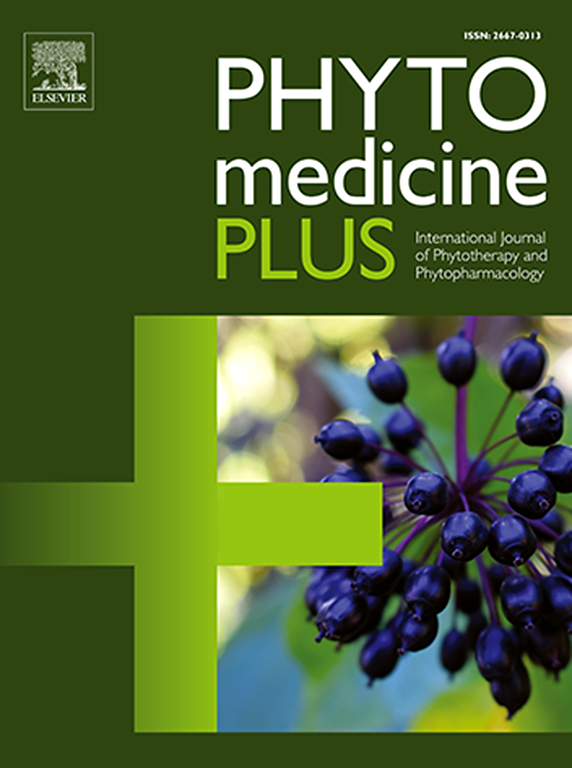90 天强制喂食导致大鼠肾上腺肥大,而肉桂无毒副作用
Q3 Pharmacology, Toxicology and Pharmaceutics
引用次数: 0
摘要
背景肉桂耳(Antrodia cinnamomea,A. cinnamomea)是一种原产于台湾的药用真菌,几十年来一直被台湾民间医师用于治疗肝损伤、癌症和炎症相关疾病。本研究的目的是在不直接评估 HPA 轴功能的情况下,根据 Harvey 的策略,考虑对常规评估的应激敏感器官系统(肾上腺和胸腺)的潜在影响,探讨大鼠在 90 天的野生肉桂试验中肾上腺肥大的原因。研究设计根据台湾食品药物管理局的《肉桂酸盐食品管理及标示规定》,并遵照经合组织(OECD)化学物质测试准则(测试编号 408)的规范,使用 Sprague-Dawley (SD) 大鼠进行为期 90 天的研究。评估方法包括临床检查、体重、进食量、血液学、凝血功能、临床生物化学、大体肉眼观察和宏观检查、器官重量和组织病理学。结果未发现 RDAC 的不良影响,确定大鼠在 3 个月内的无不良影响水平为 250 毫克/千克-1/天。观察到肾上腺皮质肥大,但肾上腺腺体与脑重量比的增加没有统计学意义(p > 0.05)。生物应激标志物的变化,包括器官和总体重、白细胞计数的变化以及进食行为的减少,表明肾上腺皮质肥大可能不是由于 RDAC 抑制了肾上腺皮质类固醇的生成。雌性大鼠表现出更强的应激反应。结论 SD 大鼠的肾上腺皮质肥大可能是由于 RDAC 难闻的苦味引起的非药物应激反应,强迫喂食过程可能会加剧这种反应。这项研究是首个在不直接评估 HPA 轴功能的情况下阐明喂食肉桂酸大鼠肾上腺肥大机制的证据。这强调了肉桂的安全性,并主张进一步开展药理学研究。本文章由计算机程序翻译,如有差异,请以英文原文为准。

Adrenal hypertrophy in rats caused by 90-day force-feeding concomitant with the non-toxic effects of Antrodia cinnamomea
Background
Antrodia cinnamomea (A. cinnamomea), a medicinal fungus native to Taiwan, has been used for decades by folk medicine practitioners to treat liver damage, cancer, and inflammation-related afflictions in Taiwan. The observation of adrenal hypertrophy in rats over a 90-day feeding wild A. cinnamomea test has been reported, however no investigation or conclusive evidence is further provided yet.
Purpose
This study aimed to explore the cause of adrenal hypertrophy in rats fed A. cinnamomea (in a 90-day study) followed by Harvey's strategy, considering potential effects on the routinely evaluated stress-sensitive organ systems (adrenal and thymus), without directly assessing the HPA axis function.
Study Design
A 90-day study using Sprague-Dawley (SD) rats was conducted in accordance with the "Regulations on Food Management and Labelling of A. cinnamomea" by Taiwan FDA, which adhere to the OECD guidelines for the testing of chemicals (Test No 408) specification.
Methods
The rats were oral gavaged with raw dish-cultured A. cinnamomea (RDAC) at a dosage of 250 mg kg-1/day for 13 weeks. The evaluation methods included clinical examinations, body weights, food consumption, haematology, coagulation, clinical biochemistry, gross visual observations and macroscopic examinations, organ weights, and histopathology.
Results
No adverse effects from RDAC were found, establishing a no-observed-adverse-effect level of 250 mg kg-1/day in rats over a 3-month period. Adrenocortical hypertrophy was observed, but the increase in adrenal-gland-to-brain-weight ratio was not statistically significant (p > 0.05). Changes in biological stress markers, including organ and total body weights, changes in leukocyte counts, as well as reduced food consumption behaviour, serve as evidence to suggest that the hypertrophy was likely not due to adrenocortical steroidogenic inhibition by RDAC. Female rats exhibited a stronger stress response. RDAC suppressed the cell infiltration of Harderian glands.
Conclusion
The adrenocortical hypertrophy in SD rats was likely a non-pharmacological stress response due to the unpleasant bitter taste of RDAC, potentially exacerbated by the force-feeding procedure. This study is the first evidence to elucidate the mechanism of adrenal gland hypertrophy in rats fed A. cinnamomea without directly assessing the HPA axis function. This underscores the safety of A. cinnamomea and advocates for further pharmacological research.
求助全文
通过发布文献求助,成功后即可免费获取论文全文。
去求助
来源期刊

Phytomedicine Plus
Medicine-Complementary and Alternative Medicine
CiteScore
3.70
自引率
0.00%
发文量
178
审稿时长
81 days
期刊介绍:
 求助内容:
求助内容: 应助结果提醒方式:
应助结果提醒方式:


